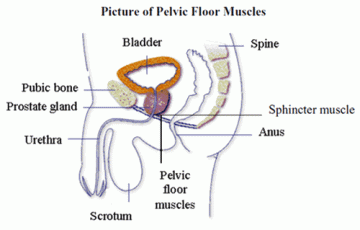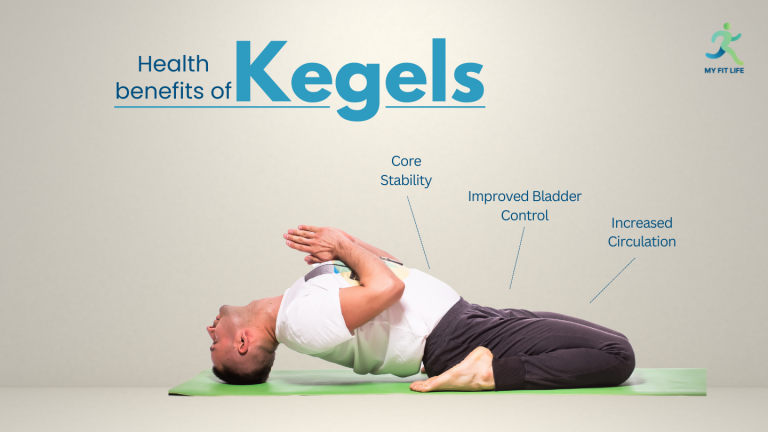“Take Control of Your Health – Strengthen Your Core from the Inside Out”
In the fitness world, we often focus on muscles like abs, chest, and arms, but there’s a vital group of muscles that often gets overlooked – your pelvic floor muscles. For men, Kegel exercises are a powerful way to strengthen these internal muscles, offering several health benefits like improved bladder control, enhanced sexual health, and better core stability.
Let’s explore why Kegel exercises matter, how to perform them, and how the MyFitLife app can guide you in mastering these exercises.
Pelvic Floor Muscles Overview
Before diving into Kegel exercises, it’s essential to understand the “Pelvic Floor Muscles.” These muscles play a key role in supporting your bladder and controlling urination.
Your pelvic floor muscles are a group of muscles that provide crucial support to the bladder and help regulate urinary control. These muscles include:

- Bladder: A balloon-shaped muscle that stores urine.
- Sphincter Muscles: Help open and close the urethra, allowing urine to pass.
- Pelvic Floor Muscle (PC muscle): Supports both the bladder and rectum, playing a vital role in maintaining control over urination and bowel movements.
Why Men Should Do Kegel Exercises
Kegel exercises offer significant health benefits for men, including:
- Improved Bladder Control: Strengthening the pelvic floor muscles can help reduce urinary incontinence, especially after prostate surgery.
- Enhanced Sexual Health: Kegels increase blood flow to the pelvic region, supporting erectile function and stamina during sex.
- Better Bowel Control: By strengthening your pelvic floor muscles, you also gain better control over your bowel movements.
- Core Stability: A strong pelvic floor can reduce strain on your lower back and help stabilize your core, improving your overall posture and strength.
- Increased Circulation: Improved blood flow in the pelvic region promotes faster recovery, relieves muscle tension, and boosts overall pelvic health.
- Prevention of Pelvic Organ Prolapse: Though more common in women, men with weakened pelvic floors can still benefit from the preventive effects of Kegel exercises.
- Premature Ejaculation: Significant improvement, with up to a 50% cure rate in studies.
- Nocturia: Reduces nighttime urination and improves sleep.
Fast facts on calories
- 70% of men report improved bladder control after consistent pelvic floor exercises post-prostate surgery.
- 50% cure rate in men with lifelong premature ejaculation after 2-6 months of Kegel exercises.
- Better sleep with reduced nighttime urination for 60% of patients.
Kegel exercises are easy to perform but require consistency for maximum benefit. Follow these steps:
- Get comfortable: You can perform Kegels while sitting, standing, or lying down.
- Contract your pelvic floor muscles: The easiest way to identify these muscles is to imagine stopping urination midstream. Those are your pelvic floor muscles.
- Hold the contraction: Once you’ve identified the muscles, contract and hold them for 3-5 seconds.
- Relax: Release the contraction and rest for 3-5 seconds.
- Repeat: Aim for 10-15 repetitions, performed 2-3 times a day.
Make sure not to tense up other muscles like your abs or thighs—focus solely on your pelvic floor for the best results.
Finding Your Pelvic Floor Muscles
Many men struggle to find their pelvic floor muscles at first, but here are two easy methods to help you:
| Method 1: While urinating, try to stop and start your urine flow a couple of times. The muscles involved in this action are your pelvic floor muscles. | Method 2: Imagine suddenly needing to stop urinating. The muscles you use to halt the flow are your pelvic floor muscles. Strengthening these through Kegel exercises can be helpful. |
When to Do Your Kegels
The great thing about Kegel exercises is their discreet nature. You can do them anywhere—during your commute, at your desk, or even while relaxing at home. Aim to integrate Kegels several times throughout your day.
- Start with shorter
- frequent sessions, and
- gradually increase both duration and frequency.
How Often Should You Do Kegel Exercises?
For the best results, consistency is key. Aim to perform Kegel exercises 2-3 times a day. Start with 10 repetitions and gradually increase to 15 or even 20 as your muscles grow stronger.
Pro Tip: Set reminders on the MyFitLife app to help you stay consistent and track your progress. Regular practice is essential for seeing long-term benefits.
Kegel Dos
- Make sure your bladder is empty.
- Find the right muscles. They’re the same muscles you’d use to stop urine midstream.
- Squeeze and hold those muscles for 10 seconds, and then relax for 10 seconds.
- Do three sets of per day, 10 to 15 Kegel exercises each.
When to Expect Results?
Kegel exercises aren’t a quick fix, but with regular practice, you should start to see improvements in 4-6 weeks. These could include better bladder control, enhanced sexual performance, and improved core stability.
Stay patient and stick with your routine—your muscles need time to strengthen.
How MyFitLife App Can Help
Want to stay on top of your Kegel routine? The MyFitLife app has everything you need to make these exercises a regular part of your fitness plan. With MyFitLife, you’ll get:
- Personalized Exercise Plans: Tailored Kegel routines based on your health goals.
- Progress Tracking: Keep an eye on your improvements with easy-to-read progress charts.
- Daily Reminders: Our app will remind you to do your Kegels so you stay on track.
The MyFitLife app is designed to help you strengthen your pelvic floor muscles while making the process easy and enjoyable. Whether you’re a beginner or looking to refine your routine, MyFitLife has you covered.




Comments are closed.